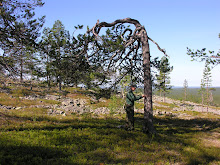Great
news: there’s a new canopy cover article online!
I’ve
tested plenty of different methods for estimating canopy cover, but the test
with satellite images that was supposed be part of my doctoral thesis was
delayed and delayed. I guess that I was still busy with other things on the day
when Janne sent me an excel file with the SPOT 5 reflectances from our Hyytiälä
sample plots. Out of curiosity, I calculated the RSR spectral index from the
reflectances and plotted the values against the lidar-based canopy cover
estimates that I had. Surprisingly, it was a really beautiful exponential
curve! The earlier results that I had seen from the boreal zone were not nearly
as impressive. I think that the reason for the very good accuracy was that we
used lidar-based canopy cover estimates instead of quickly measured, inaccurate
field values.
So nice!
It still
took more than a year until I finally started writing the paper last winter in
Norway. I tried to keep things simple – one problem, one data set for modelling
and another for validation, and two spectral indices to compare. After some
reviews, the paper was accepted quicker than I thought. It is always nice when
you can keep things simple, but unfortunately all of our problems are not as easy.
Hyytiälä from satellite







